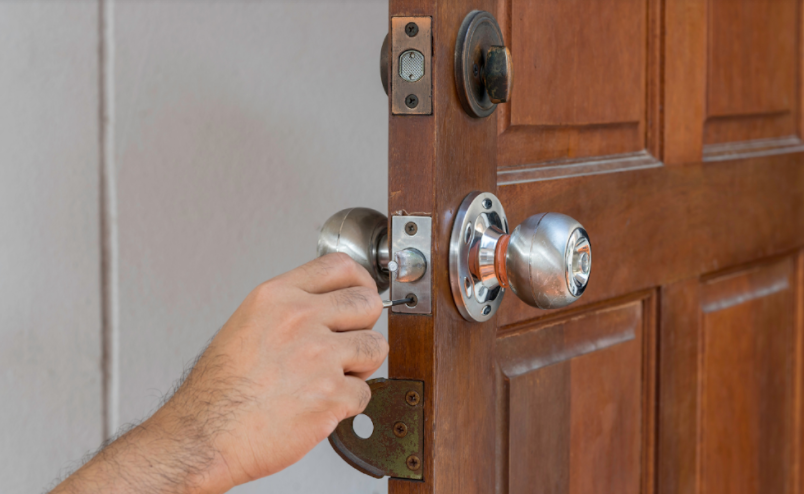Your locks may not function properly due to a misplaced deadbolt, loose screws, or rusting,
so you should know how to fix a door lock that won’t turn. There is no one-size-fits-all
solution for a jammed door lock; the reason for the jam will determine the method you select.
However, don’t worry if this all sounds complicated; it isn’t. Your lock will be as fine as new
with just a few simple tools and equipment.
Material and Tools You Need
● Dry lubricant spray
● Philips-head screwdriver or an appropriate screwdriver
● Key extractor
Step By Step Process on How to Fix a Door Lock that Won’t
Turn
Check The Hinges to Tight Them
If a door hinges are slack, the latch may lie lower than the striker panel, making the lock
difficult to operate. You can start doing door lock repair with the help of the below steps:
Although, examine the door and the doorframe for any gaps. The hinges may be loose if the
door appears to be tilted. To reveal the hinges, open the door. Then tighten any loose
screws using a Philips head screwdriver. It must raise the door enough as the deadbolt to
lock itself into the striking plate.
Tight the Screws
A loose set screw could be the cause of your door knob turning but not opening it up. It is the
screw that links the inner and outer knobs to the shaft that holds the knob in place. To fix a
knob that rotates but did not open, use these actions:
Track down the screws. On the base or bottom of the knob, some locks include visible
setscrews. However, if you can not find any bolts, remove the knob faceplate to gain access to
the screws underneath.
Tighten loose screws with the appropriate screwdriver. Put lubricant on the bolts to make
them easier to turn.
Ensure that You Lubricate the Spring Mechanism
The lock innerspring system may be malfunctioning if the deadbolt does not fully extend
when you turn the handle. When opening and shutting the door, the spring system assists in
turning the knob.
Make the spindles visible. Remove the knobs and take them entirely out of the lock to reveal
the spindle, which is part of fixing a door lock spring system. While spinning the other knob,
spray a little amount of Teflon oil on the spindle and springs. The spring mechanism should
be unbound, and the deadbolt should slide easily as a result. Replace the knob and make
sure the screws are tight.
Use a Key to Fix Problem
Grooves on the key, insufficient lubricants, and even cold temperatures are all possible
causes of a key that won’t open or lock the door.
Examine the key for grooves that can prohibit it from opening the lock. Apply a modest
quantity of granite to the key, then insert and turn it in the lock before removing it. The areas
without granite are scraping against the inside locking mechanism and should be filed down.
The key should fit into the keyhole smoothly and unlock the latch.
However, if the lock does not turn with the door open, try greasing the key and socket to
remove any rust preventing the lock from turning.
Lock Jammed with Broken Key
To turn a lock that a broken key has jammed, you will need a specific gadget called a key
extractor.
You should spray lubricant into the keyholes. Then, insert the extractor curved end into the
hole. Moreover, the extractor edges should face the critical ridges.
Slide the ejector in and out carefully until it interlocks with the key inside. To remove the key,
try pulling the ejector from the keyhole.
Align Strike Plate with the Deadbolt
The strike plate may start shifting for some reason, preventing the bolt from slipping into the
slot and closing the door. The strike plate will need to be moved, enlarged, or repositioned to
the level of the lock latch in this case. You can also get locksmith services to ease
yourself.
To relocate it, use a tool to gently tap the bottom lip of the strike plate hole with a hammer.
For the lock to go in freely, the strike plate must move down about 1/8 inch.
Try expanding the striking plate hole if the lock is still blocked. Pull the strike plate from the
frame using a screwdriver. Then, with a metal file, file down the strike plate bottom lip.
Reduce as much brass as necessary to allow the lock latch to slip into the socket easily.
Adjust the strike plate as appropriate.
Reposition the striking plate if shifting or extending it does not address the problem.
Reposition the plate about 1/8 inch below the former screw point after removing it from the
jamb. The latch should now fit in the plate hole, and it should unjam the lock.
Solve Temperature-Related Issues
As strange as it may seem, the functioning of your door locks and keys may be influenced by
climate. If the key does no turn on a winter day, use a hairdryer to apply heat to the keys and
key slot. A little heat may be all that is required to engage the lock.

